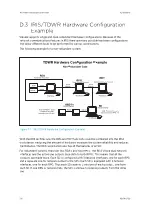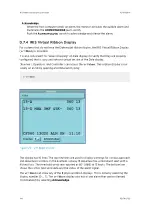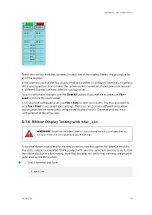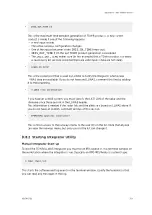
The hinged front panel drops down to access the local controls. The controls area is
illuminated when the door is open.
Self Test
Hold in the
SELF TEST
push button to write the character set to the display. The
monitor's ID number, model number, and software version are shown on the last line
of the self test screen.
If required, you can use the selector switch can be adjusted to change the ID number.
The audio alarm is activated and you can adjust the volume and warble.
If data is sent to the monitor while
SELF TEST
is depressed, the monitor sets
D6
and
D7
(of the status byte) high when the button is released to indicate that data sent to
the unit was not captured and that the screen should be regenerated.
Brightness
Use the
BRIGHTNESS
control to adjust the display brightness.
To increase brightness rotate the control clockwise.
When the control is rotated to its extreme counter-clockwise position (past a switch
detent) the brightness is controlled automatically according to the amount of ambient
light in the room.
Normal
/
Bypass
Put the switch in the
NORMAL
position to enable communication between the
monitor, host, and other peripherals.
Put the switch in the
BYPASS
position to route the RS-232D signals are routed around
the monitor.
This hardware switch isolates the monitor's I/0 circuitry when in the
BYPASS
position.
Selector
You can set the monitor's identification number can be set from 0 ... 7 through the
recessed switch.
To set the identification number, push and hold the SELF TEST button, and adjust the
SELECTOR
control until the desired number is displayed on the screen. Note: There
are three positions that display 0. All work as ID
#0
.
Alarm Controls and Adjustments
The audible alarm is 2 tones that are alternately turn on and off to create a "warble"
effect.
You can adjust the parameters of the warble using the
DURATION
,
FREQUENCY
, and
WARBLE
adjustments.
Volume
Use the
VOLUME
control to adjust the audible alarm loudness between 60 ... 85 dBa.
Turn the control fully counter-clockwise to disable the alarm speaker output. Loudness
is increased with clockwise rotation and decreased with counter clockwise rotation.
Duration
Varies the on/off time (duty cycle) of the two tones.
Frequency
Raises or lowers the frequency of the 2 warble tones.
Warble
Varies the rate at which the 2 tones are alternated.
Appendix D – IRIS TDWR Features
RESTRICTED
345
Summary of Contents for IRIS
Page 1: ...M211319EN H RESTRICTED User Guide IRIS Radar IRIS Product and Display...
Page 12: ...IRIS Product and Display User Guide M211319EN H 10 RESTRICTED...
Page 71: ...Chapter 3 Configuring IRIS Products RESTRICTED 69...
Page 303: ...Figure 103 Typical Spectrum Plot Appendix A Basic Radar Meteorology RESTRICTED 301...
Page 386: ......
Page 392: ......
Page 393: ......
Page 394: ...www vaisala com...
















































